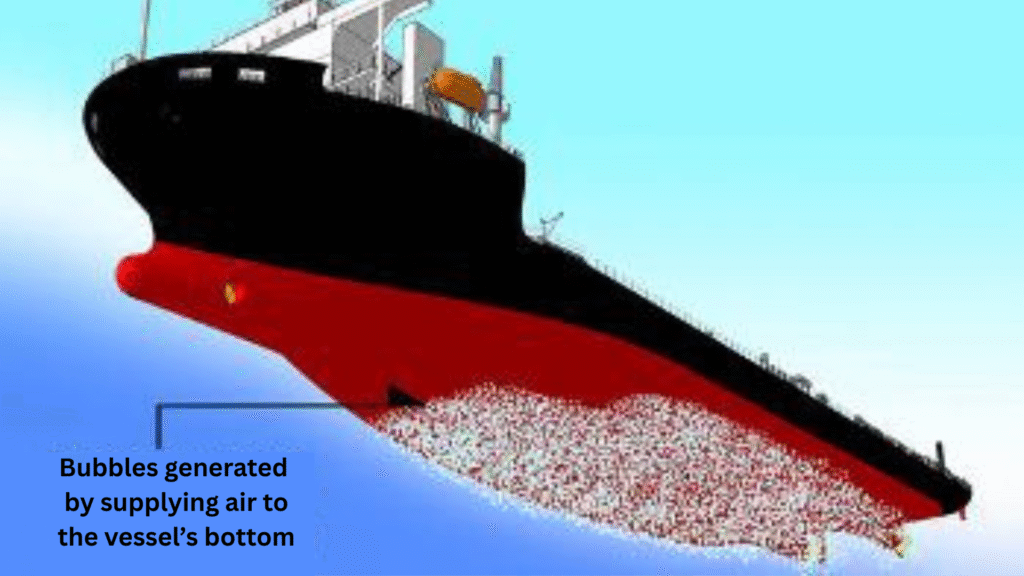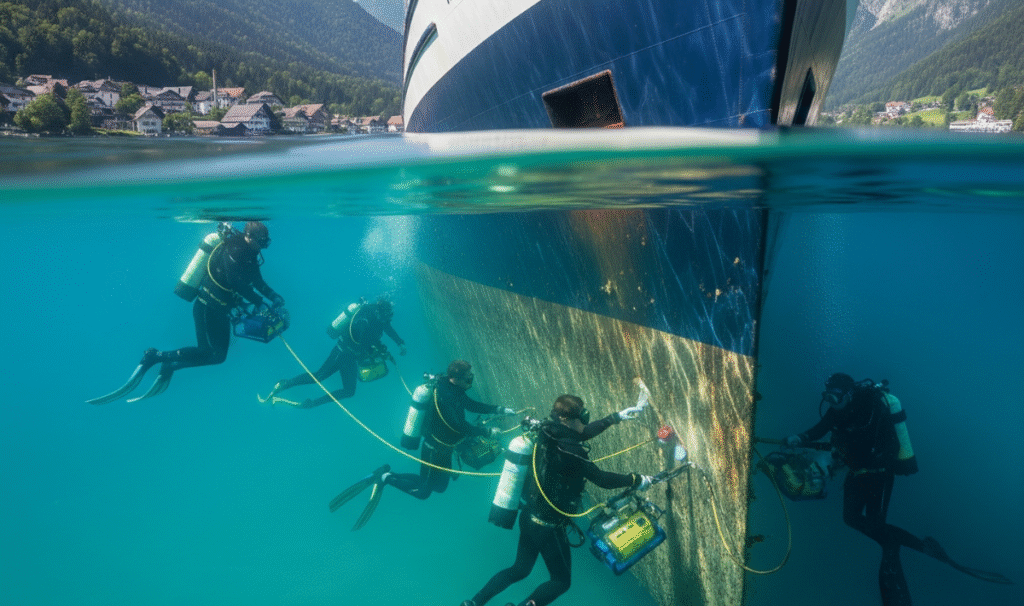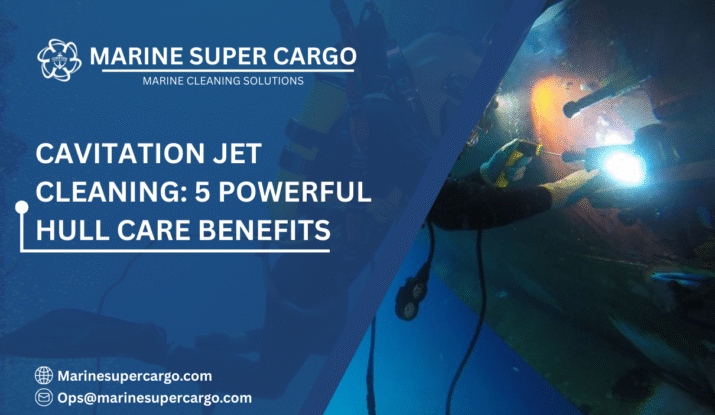If you’ve ever tried scrubbing stubborn stains off a wall and realized that your ordinary sponge just wasn’t cutting it, you’ll understand the challenge ship owners face with fouled hulls. Over time, marine organisms—barnacles, algae, mussels—settle firmly onto the smooth steel surfaces of vessels. These cling-ons increase drag, reduce efficiency, and force engines to consume more fuel.
Enter cavitation jet cleaning—a revolutionary technology that uses the natural physics of collapsing bubbles to remove biofouling without damaging coatings. Imagine using the microscopic force of imploding bubbles, powerful enough to clean but gentle enough to preserve surfaces. It’s not science fiction; it’s today’s cutting-edge hull cleaning solution.
In this in-depth guide, we’ll walk through what cavitation jet cleaning is, how it works, the advantages it offers ship operators, and its role in shaping the future of sustainable maritime maintenance.
Why Hull Cleaning Matters
Hull cleaning is not a vanity task—it’s central to vessel performance and compliance. Left unchecked, biofouling significantly increases hydrodynamic drag. The International Maritime Organization (IMO) notes that heavy fouling can push fuel consumption up by as much as 40%.
Fuel isn’t the only concern. More drag means higher greenhouse gas emissions, complicating compliance with IMO’s greenhouse gas reduction initiatives and MARPOL Annex VI. On top of that, fouled hulls carry invasive species across oceans, violating biofouling management rules emphasized by IAPH and IMCA.
Simply put: a fouled hull is like running a marathon with ankle weights—it slows you down, burns more energy, and makes compliance harder.

Traditional Hull Cleaning Drawbacks
Historically, hull cleaning has been handled through brushes, scrapers, or high-pressure water jets operated by divers or remotely operated equipment. While these methods remove fouling, they introduce drawbacks:
- Surface damage: Aggressive scrubbing can damage expensive anti-fouling coatings.
- Safety risks: Human divers deal with entanglement, decompression illness, and poor visibility.
- Biofouling spread: Traditional cleaning often releases species into local waters, threatening ecosystems.
- High costs: Manual cleaning leads to downtime and inconsistent cleanliness.
This is where the elegance of cavitation jet cleaning shines.
What is Cavitation Jet Cleaning?
At its core, cavitation jet cleaning relies on a phenomenon known as cavitation. Cavitation happens when powerful water jets create microscopic vapor bubbles in liquid. These bubbles collapse instantly and release energy—creating localized shockwaves.
In hull cleaning, these collapsing bubbles concentrate energy on biofouling layers. They dislodge organisms and slime while leaving hull coatings intact. Think of it like tapping gently but repeatedly on a glued postcard until it peels away—effective yet gentle. Learn more
How Cavitation Jet Cleaning Works
Here’s the step-by-step breakdown of how cavitation jet cleaning is applied to ships:
- High-pressure water jets: Specially designed nozzles shoot streams of water at controlled pressure.
- Cavitation formation: Vapor bubbles form within the jet stream as pressure drops momentarily below vapor pressure.
- Bubble collapse: Microbubbles collapse near the hull surface, releasing shockwaves of energy.
- Biofouling removal: The mechanical micro-impact dislodges barnacles, algae, and slime.
- Preservation: Unlike high-pressure blasting, cavitation avoids stripping protective coating layers.
The result? A cleaner hull, minimal surface damage, and reduced environmental spillover of biofouling.
Key Benefits of Cavitation Jet Cleaning
1. Protection of Hull Coatings
Anti-fouling coatings like silicone or specialized paints are expensive investments. Traditional scraping can chip away at them, shortening service life. Cavitation jet cleaning removes fouling without extensive abrasion, safeguarding coating lifespans.
Also read about: Underwater ship hull cleaning in Ecuador.
2. Enhanced Safety
By reducing reliance on divers, cavitation jet cleaning minimizes underwater risks. Many systems today integrate with remotely operated platforms, combining advanced cleaning with enhanced personnel safety.
3. Regulatory Compliance
This method aligns better with MARPOL and IMO biofouling guidelines because controlled cavitation jets reduce uncontrolled dispersal of organisms while promoting eco-friendly cleaning.
4. Cost Savings
Fuel efficiency gains can quickly repay the investment in cavitation cleaning systems. Studies show smoother hulls translate into 10–20% savings, delivering strong ROI for ship operators.
5. Environmental Responsibility
Beyond cost, cleaner hulls reduce emissions and minimize invasive species risks, reinforcing shipping’s role in climate action and marine conservation.
Practical Applications
Cavitation jet cleaning is actively being applied across shipping sectors:
- Container carriers: Frequent port calls make biofouling a constant challenge. Cavitation enables fast, compliant cleanings.
- Bulk carriers & tankers: Fuel savings add immense value on long voyages.
- Offshore platforms: Cavitation tools maintain submerged structures without harsh abrasives.
- Naval forces: Preserving stealth coatings while maintaining vessel performance is crucial. Cavitation offers a balance.
At Marine Super Cargo, we provide trusted marine cleaning solutions across 1,100+ ports worldwide. From hold cleaning to underwater hull cleaning and tank cleaning, our services are designed to keep your fleet fully compliant, efficient, and cargo-ready. pic.twitter.com/N5VYZZjlQH
— Marine Super Cargo (@Marinsupercargo) September 11, 2025
Environmental Advantages of Cavitation Jet Cleaning
The IMO’s biofouling management guidance stresses not only maintaining ship efficiency but also protecting ecosystems. Traditional cleaning risks releasing significant amounts of fouling debris into surrounding waters.
With cavitation jet cleaning, the effect is more controlled. Cavitation jets can be integrated with collection systems, allowing safe capture of dislodged materials for disposal ashore. This aligns well with IAPH initiatives focusing on invasive species management in global ports.
Limitations of Cavitation Jet Cleaning
Of course, no technology is without challenges:
- Capex considerations: Systems can be costly upfront and may intimidate smaller operators.
- Training requirements: Operators require technical know-how to use cavitation systems effectively.
- Material compatibility: Non-steel surfaces and sensitive paints may limit applicability in some vessel types.
- Power consumption: High-pressure systems demand significant onboard energy.
Despite these challenges, ongoing R&D by maritime consultancies and standard-setting groups like IMCA is ironing out hurdles.

The Future of Cavitation Jet Cleaning
Looking ahead, cavitation jet cleaning is set to become smarter and more automated. Integration with robotics and Artificial Intelligence could allow fully autonomous hull-cleaning units to operate at ports, combining cavitation jets with real-time inspection analytics.
Machine learning may optimize cleaning cycles based on hull roughness data. Over time, predictive cleaning schedules could emerge, ensuring ships are cleaned before fouling impacts performance.
Imagine arriving at a port where robotic cleaners employ cavitation jets while cargo operations proceed—seamless, efficient, and environmentally sound. That vision may soon be reality. Learn more.
Conclusion
Cavitation jet cleaning is more than just an emerging technology—it’s a revolutionary approach to hull maintenance. It balances efficiency, environmental responsibility, and cost reduction better than traditional methods.
3 Key Takeaways:
- Cavitation jet systems deliver cleaner results without damaging coatings.
- They support IMO and MARPOL compliance, reducing invasive species risks.
- Operators gain real ROI through fuel savings and lower emissions.
The path forward in hull cleaning is clear—and it’s powered by innovation. For in-depth insights and sustainable solutions tailored to your fleet, we recommend exploring CleanShip.co.
FAQ:
Q1. What is cavitation jet cleaning in hull maintenance?
It is a cleaning technology that uses collapsing bubbles created by high-pressure water jets to safely and effectively remove biofouling without damaging coatings.
Q2. How does cavitation jet cleaning compare with traditional cleaning?
It is gentler on coatings, safer for crews, and better aligned with IMO environmental guidelines compared to brushes or high-pressure scrubbing.
Q3. Is cavitation jet cleaning environmentally friendly?
Yes. With integrated collection systems, it reduces the release of invasive species and supports compliance with MARPOL and IAPH rules.
Q4. Can all ships use cavitation jet cleaning?
Most steel-hulled vessels, offshore units, and naval ships can use it. However, results may vary with softer coatings or unique hull materials.
Q5. What is the future of cavitation jet cleaning?
Expect increased automation, AI integration, and port-based robotic cleaning stations combining cavitation with predictive maintenance.


